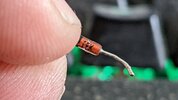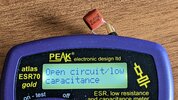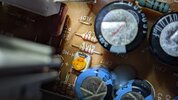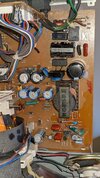1084st bloke
New Member
Hi there, I have a Commodore 1084ST computer monitor I'm trying to repair and would appreciate some help identifying a component. The problem is exacerbated by the lack online of any service manuals, so I'm currently drawing my own circuit diagram (it's going slowly). I have basic electronics experience and have repaired a few vintage 8-bit computers and the like. I haven't worked on a CRT before (I understand how to discharge the tube).
The monitor had a fault where it would blow the internal fuse immediately on powerup. So I traced that back to a shorted MOSFET on the switch mode power supply. The replacement MOSFET blew immediately, so I looked further back and found that a TDA4605 controller was pretty much shorted between the supply and earth pins.
So I've replaced the MOSFET and IC now, but I thought I'd have a look on the supply pin before I ruined that IC and another MOSFET. There's what I think is a diode protecting it, but I can't identify it. I think the text is 1N4. I have a strip of 1N4148 diodes and wondered if it'd be appropriate to substitute.
I should add that I've checked the bridge rectifier and that's fine, as are the filter caps and other components nearby. I understand the monitor has some power supply protection from problems closer to the back of the tube, so at this point I'm mainly concerned with getting the power LED on. The person I bought it from said "it just turned off" so my guess is it's purely a PSU problem.
Here's the 4605 datasheet - https://www.alldatasheet.com/datasheet-pdf/pdf/25064/STMICROELECTRONICS/TDA4605.html

The monitor had a fault where it would blow the internal fuse immediately on powerup. So I traced that back to a shorted MOSFET on the switch mode power supply. The replacement MOSFET blew immediately, so I looked further back and found that a TDA4605 controller was pretty much shorted between the supply and earth pins.
So I've replaced the MOSFET and IC now, but I thought I'd have a look on the supply pin before I ruined that IC and another MOSFET. There's what I think is a diode protecting it, but I can't identify it. I think the text is 1N4. I have a strip of 1N4148 diodes and wondered if it'd be appropriate to substitute.
I should add that I've checked the bridge rectifier and that's fine, as are the filter caps and other components nearby. I understand the monitor has some power supply protection from problems closer to the back of the tube, so at this point I'm mainly concerned with getting the power LED on. The person I bought it from said "it just turned off" so my guess is it's purely a PSU problem.
Here's the 4605 datasheet - https://www.alldatasheet.com/datasheet-pdf/pdf/25064/STMICROELECTRONICS/TDA4605.html





